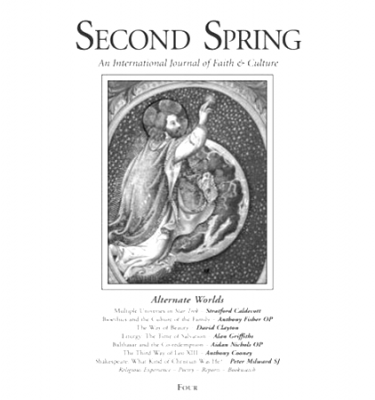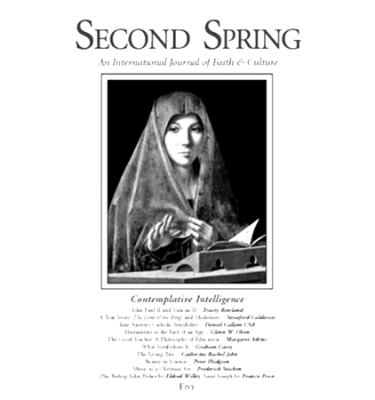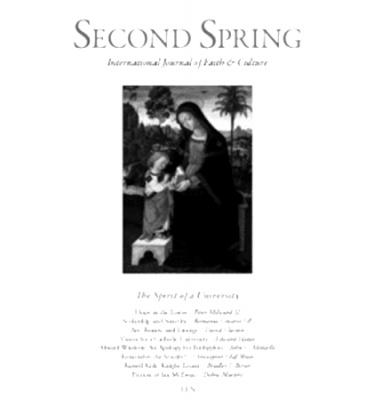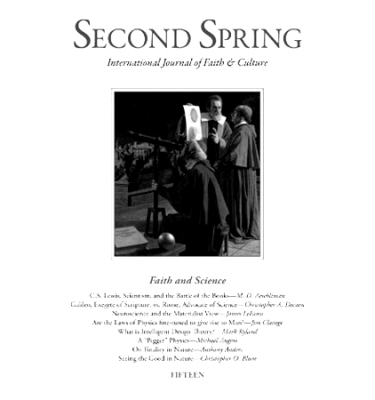Second Spring: An International Journal of Faith and Culture
Founded and edited by Stratford and Léonie Caldecott, Second Spring’s mission is to explore and advance the mission of a Catholic intellectual in the context of contemporary culture. Second Spring is substantive, thought-provoking, topical, and deeply rooted in the Christian tradition that created European culture. It takes its bearings from leading Catholic theologians such as Pope Emeritus Benedict XVI in his lifelong writings, as well as Catholic thinkers such as John Henry Cardinal Newman, Hans Urs Von Balthasar, and G.K. Chesterton. Subjects regularly covered in Second Spring include the arts, sciences, technology, liturgy, new ecclesial movements, metaphysics, history, literature, poetry, and the world of books.
Each issue of Second Spring normally spans a range of cultural areas, because its intention is to view all things in the light of Christ. We choose the best writing we can find and edit each issue carefully to make sure that it can be read by the general reader as well as professional academics. The overarching purpose of the journal is to serve the New Evangelization, which Pope John Paul II termed an “evangelization of culture”: specifically by the renewal of education in the broadest sense—education in the faith, as well as education in the latest ideas in the sciences and the humanities. We are not a journal of news and opinion, and so our issues do not go rapidly out of date.
True evangelization happens when an ethos, a way of living, is communicated. To evangelize is not merely to convey a set of ideas: it is to give a “reason for the hope that is in us”. Second Spring seeks to open hearts and minds to the great tradition of Christian humanism, rightly understood: the cultivation of intelligence, conscience, and grace.
History
At the beginning of the 1990s, we decided to create a forum to explore, from within the Catholic tradition, the beauty that inspires conversion to Christianity and the creation of a Christian culture. We wanted to respond to the call of John Paul II for a “new evangelization”, in gratitude for the gift of faith we had ourselves received. We began to visualise a magazine that would be imbued with the spirit of faith and of the joy that comes from faith. However it would not dwell exclusively on the Church and theology, but turn its attention to the world of science, of literature, of economics, of art and architecture, of history. It would not be afraid of tackling theology, but it would do so in a way that was open to human experience and would relate theology to the deepest concerns of the human heart. It would be about spirituality as well as culture, about social action as well as intellectual analysis. It would be committed to truth wherever we could find it.
The gap between faith and culture, which Paul VI called the “drama of our times”, cannot be addressed by an attempt simply to recover a world that has been lost: a mythical golden age set back in the 1950s, the 1870s or the Middle Ages. Yes, we need to restore and retrieve much that has been lost or forgotten. But we wanted to do it within a new cultural moment, learning from the past, not merely repeating it. In particular, we believed that the Second Vatican Council, for all the upheavals associated with its aftermath, was an act of the Holy Spirit that made possible a new springtime of the faith in the twenty-first century. Its true fruits are only now beginning to be manifest.
Between 1992 and 1999 Second Spring appeared as a quarterly supplement within the Ignatius Press magazine Catholic World Report. From 1994 we were building up the Centre for Faith & Culture in Oxford, together with its twice-yearly Faith & Culture Bulletin, as the supporting structure for the forum we wanted to create. In 2000 we established the Second Spring website, and in 2007 (from Issue Eight) the Thomas More College of Liberal Arts in New Hampshire took over the publication and distribution of the journal.
Through all these means, and the conferences we organised each year, we were making contact with others who felt the same need we did. Friends, old and new, became collaborators, and a complex network began to form, of individuals and institutions in many countries that all wanted roughly the same thing: a thing that is hard to put into words, but which we all recognise when we see it. It has something to do with hope, and something to do with beauty. We hope you will catch a glimpse of it when you read these pages.
In 2014, Stratford passed away as Issue Eighteen was published. For this reason, the journal went into hiatus. In the years since Stratford’s death our resources have been increasingly limited, and therefore we have not been able to maintain print publication for now. We are developing our online material through “Second Spring Current”, and back issues of Second Spring are available from our Shop.
Submission Guidelines
We are not currently accepting unsolicited material. Please check back soon.





